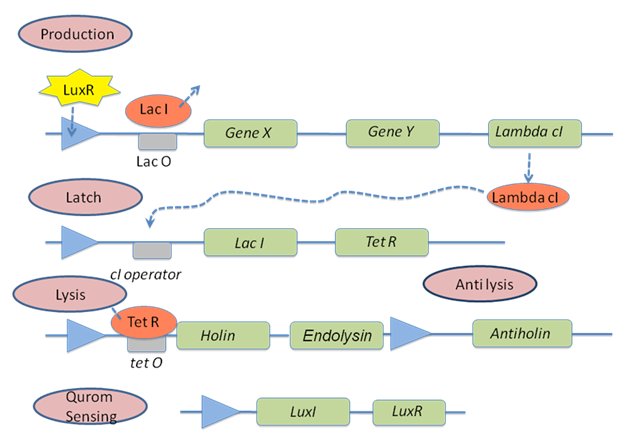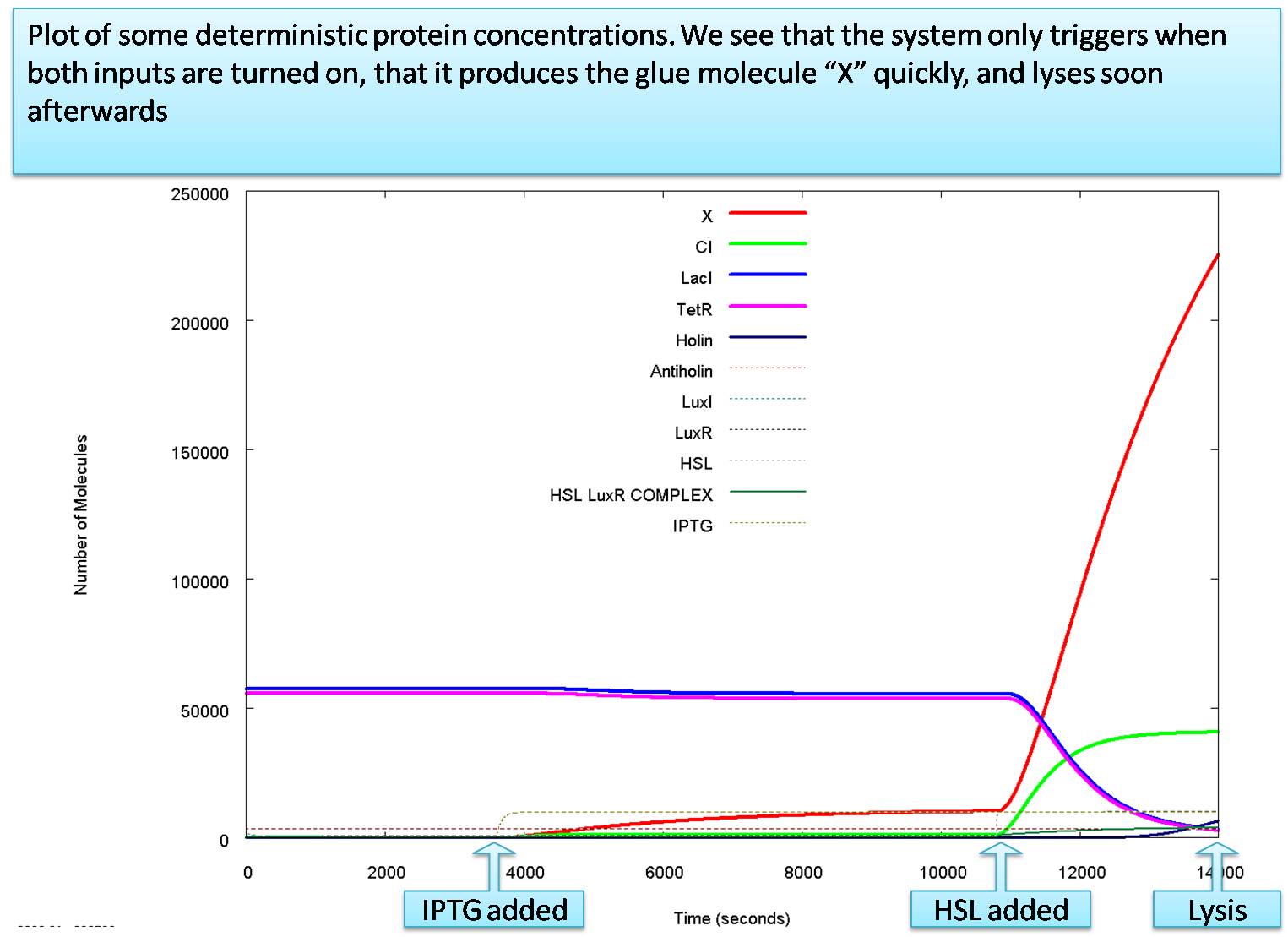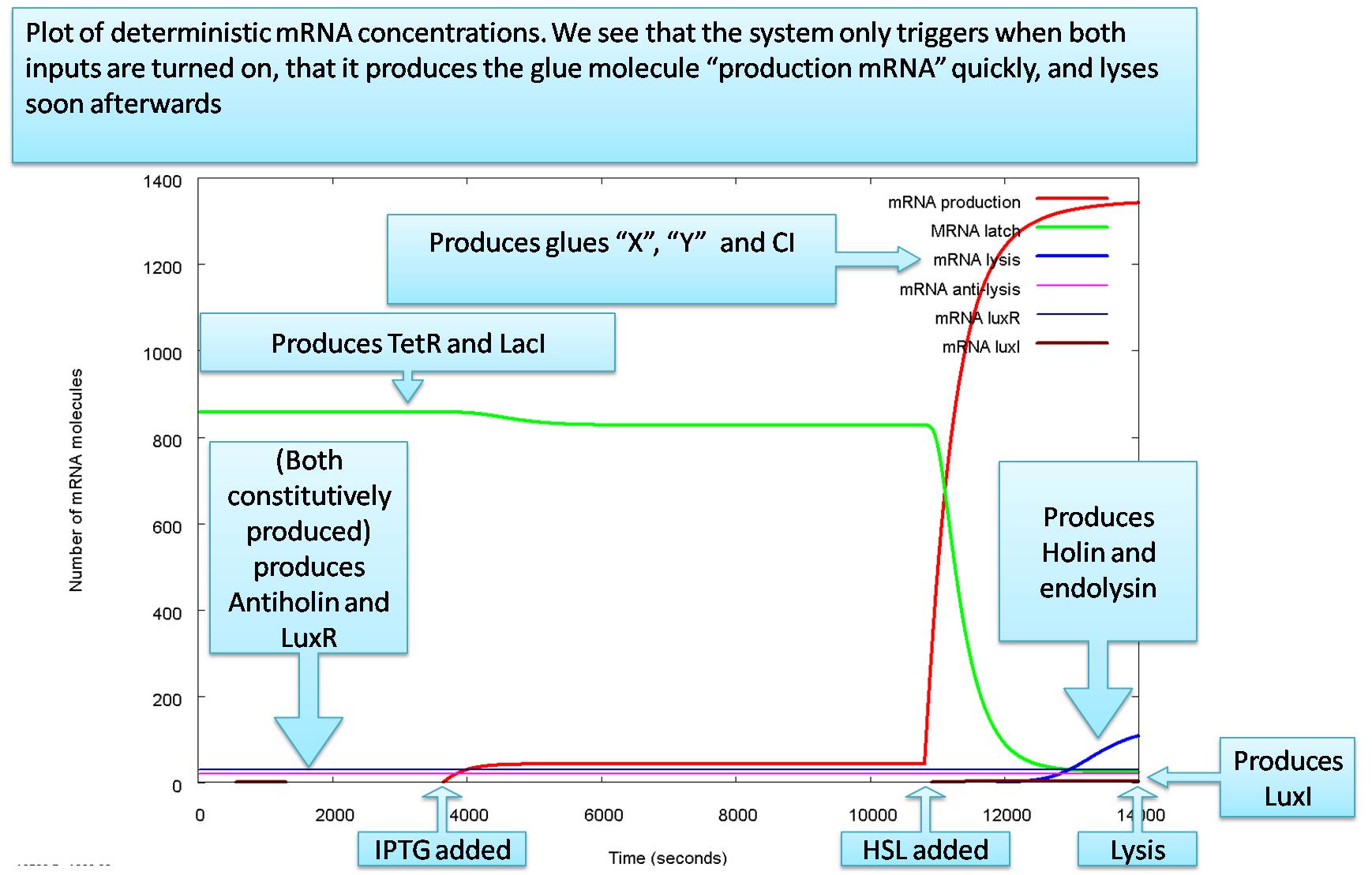Team:Aberdeen Scotland/internal/deterministic
From 2009.igem.org
(→Equations for mRNA transcription) |
|||
| (34 intermediate revisions not shown) | |||
| Line 8: | Line 8: | ||
Our circuit is constructed on 5 different plasmids, with the aim of using no more than 2 different plasmids for the final construction. From each plasmid, mRNA is transcribed, followed by ribosome translation of these mRNA strings into proteins. For the different promoters the maximal transcription rate varies depending on the polymerase affinity to the promoter. | Our circuit is constructed on 5 different plasmids, with the aim of using no more than 2 different plasmids for the final construction. From each plasmid, mRNA is transcribed, followed by ribosome translation of these mRNA strings into proteins. For the different promoters the maximal transcription rate varies depending on the polymerase affinity to the promoter. | ||
| - | First we split the different constructs according to the different mRNA they produce. We have 5 different constructs, each of which is assigned an arbitrary name. The first construct | + | First we split the different constructs according to the different mRNA they produce. We have 5 different constructs, each of which is assigned an arbitrary name. The first construct produces mRNA<sub>Production</sub>. These pieces of mRNA then produce GFP (as a temporary proof of concept) and CI. |
The second construct, which produces LacI and TetR, is named mRNA<sub>latch</sub>. Holin and Endolysin are transcribed from the mRNA produced by the mRNA<sub>lysis</sub> construct. We term mRNA coding for Antiholin mRNA<sub>antilysis</sub>. Finally, the quorum sensing proteins - LuxI and LuxR - are transcribed by the last mRNA, which is termed mRNA<sub>qs</sub>. | The second construct, which produces LacI and TetR, is named mRNA<sub>latch</sub>. Holin and Endolysin are transcribed from the mRNA produced by the mRNA<sub>lysis</sub> construct. We term mRNA coding for Antiholin mRNA<sub>antilysis</sub>. Finally, the quorum sensing proteins - LuxI and LuxR - are transcribed by the last mRNA, which is termed mRNA<sub>qs</sub>. | ||
| Line 24: | Line 24: | ||
== Equations for mRNA transcription == | == Equations for mRNA transcription == | ||
| - | The differential equations for the mRNA transcription include a production and a degradation term. The DNA sequence is placed on p plasmids and transcript at a rate β. The mRNA degrades with a rate α, and a dilution term including cell reproduction. We use Hill input functions to model the behaviour of the repressors and the activator. | + | The differential equations for the mRNA transcription include a production and a degradation term. The DNA sequence is placed on p plasmids and transcript at a rate β. The mRNA degrades with a rate α, and a dilution term including cell reproduction. We use Hill input functions to model the behaviour of the repressors and the activator. <html><br><br><br></html> |
| - | [mRNA Production] – AND – gate behaviour; repressed by LacI, induced by IPTG and activated by P | + | '''[mRNA Production] – AND – gate behaviour; repressed by LacI, induced by IPTG and activated by P''' |
<html><img src="https://static.igem.org/mediawiki/igem.org/d/dd/Eq1.gif"></html> | <html><img src="https://static.igem.org/mediawiki/igem.org/d/dd/Eq1.gif"></html> | ||
| - | |||
| - | |||
| - | |||
| - | |||
| - | |||
| - | |||
| - | |||
| - | |||
| - | |||
| - | |||
| - | |||
| - | |||
| + | '''[mRNA Latch] – repressed by cI''' | ||
| + | <html><br><br><img src="https://static.igem.org/mediawiki/igem.org/a/a9/Equ2.gif"><br><br></html> | ||
| + | |||
| + | |||
| + | '''[mRNA Lysis] – repressed by TetR''' | ||
| + | <html><br><br><img src="https://static.igem.org/mediawiki/igem.org/a/ad/Eq3.gif"><br><br></html> | ||
| + | |||
| + | |||
| + | '''[mRNA Antilysis] – constitutively produced''' | ||
| + | <html><br><br><img src="https://static.igem.org/mediawiki/igem.org/e/ee/Eq4.gif"><br><br></html> | ||
| + | |||
| + | |||
| + | '''[Quorum Sensing] (QS) – constitutively produced''' | ||
| + | <html><br><br><img src="https://static.igem.org/mediawiki/igem.org/5/52/Equation5.gif"><br><br></html> | ||
| + | |||
| + | '''[mRNA luxI] – improvement of gene circuit, LuxI is produced on an amplifying loop''' | ||
| + | <html><br><br><img src="https://static.igem.org/mediawiki/igem.org/8/8f/Equation19.gif"><br><br></html> | ||
{{:Team:Aberdeen_Scotland/break}} | {{:Team:Aberdeen_Scotland/break}} | ||
== Equations for Protein translation == | == Equations for Protein translation == | ||
| - | + | Ribosomes translate proteins from the mRNA code. The second term describes the degradation a rate α including dilution.<html><br><br></html> | |
| - | + | '''[Gene X] - Component of the glue; currently replaced by GFP''' | |
| - | [ | + | <html><br><br><img src="https://static.igem.org/mediawiki/igem.org/a/ad/Equation6.gif"><br><br></html> |
| - | + | ||
| - | |||
| - | |||
| + | '''[Gene Y] – Component of the glue; currently replaced by GFP''' | ||
| + | <html><br><br><img src="https://static.igem.org/mediawiki/igem.org/c/c4/Equation7.gif"><br><br></html> | ||
| - | |||
| - | |||
| - | |||
| - | |||
| - | |||
| - | |||
| - | |||
| - | |||
| - | |||
| - | |||
| - | < | + | '''[Lambda cl] – represses production of LacI and TetR''' |
| - | < | + | <html><br><br><img src="https://static.igem.org/mediawiki/igem.org/d/d3/Equation8.gif"><br><br></html> |
| - | + | ||
| - | + | ||
| - | |||
| - | |||
| - | |||
| - | |||
| + | '''[LacI] – represses production of glue and cI; induced by IPTG''' | ||
| + | <html><br><br><img src="https://static.igem.org/mediawiki/igem.org/2/23/Equation9.gif"><br><br></html> | ||
| - | |||
| - | |||
| - | |||
| - | |||
| - | < | + | '''[TetR] – represses production of Holin and Endolysin''' |
| - | < | + | <html><br><br><img src="https://static.igem.org/mediawiki/igem.org/b/b3/Equation10.gif"><br><br></html> |
| - | + | ||
| - | + | ||
| - | |||
| - | |||
| - | |||
| - | |||
| - | < | + | '''[Holin] – We assume lysis starts when the concentration of Holin is 1000 higher than the concentration of Antiholin''' |
| - | < | + | <html><br><br><img src="https://static.igem.org/mediawiki/igem.org/a/a9/Equation11.gif"><br><br></html> |
| - | + | ||
| - | + | ||
| - | |||
| - | |||
| - | |||
| - | |||
| - | < | + | '''[Endolysin] - breaks the cell membrane''' |
| - | < | + | <html><br><br><img src="https://static.igem.org/mediawiki/igem.org/9/94/Equation12.gif"><br><br></html> |
| - | + | ||
| - | + | ||
| - | |||
| - | |||
| - | |||
| - | |||
| - | < | + | '''[Antiholin] – forms of lysis complex''' |
| - | < | + | <html><br><br><img src="https://static.igem.org/mediawiki/igem.org/a/ad/Equation13.gif"><br><br></html> |
| - | + | ||
| - | + | ||
| - | |||
| - | |||
| - | |||
| - | |||
| - | < | + | '''[LuxI] – produces via an enzymatic process HSL''' |
| - | < | + | <html><br><br><img src="https://static.igem.org/mediawiki/igem.org/6/61/Equation21.gif"><br><br></html> |
| - | + | ||
| - | + | ||
| - | < | + | '''[LuxI] – improvement of gene circuit, LuxI is produced on an amplifying loop; produces via an enzymatic process HSL''' |
| - | < | + | <html><br><br><img src="https://static.igem.org/mediawiki/igem.org/2/2a/Equation22.gif"><br><br></html> |
| - | < | + | |
| - | </ | + | '''[LuxR] – forms complex with HSL''' |
| - | </ | + | <html><br><br><img src="https://static.igem.org/mediawiki/igem.org/1/18/Equation15.gif"><br><br></html> |
| - | <br><br> | + | {{:Team:Aberdeen_Scotland/break}} |
| + | |||
| + | == Equations for HSL, IPTG and P == | ||
| + | HSL and IPTG diffuse through the cell membrane at a rate theta. If the exterior concentration of the molecules is larger then the interior concentration, HSL and IPTG flux into the cell. Otherwise, the cell diffuses HSL and IPTG. | ||
| + | HSL collides with LuxR to form the complex P at a rate k<sub>P</sub> - and the complex P dissociates into HSL and LuxR at a rate k<sub>-P</sub>. Since P is a complex of HSL and LuxR, it will break as well when LuxR degrades. Thus the degradation rate for P is the same as the one for LuxR. Because HSL degrades later, it will be left and counted into the HSL concentration again.<html><br><br></html> | ||
| + | '''[HSL] – forms complex with LuxR''' | ||
| + | <html><br><br><img src="https://static.igem.org/mediawiki/igem.org/6/64/Equation16.gif"><br><br></html> | ||
| + | '''[IPTG] – forms complex with LacI, thereby changing the affinity of LacI to LacO''' | ||
| + | <html><br><br><img src="https://static.igem.org/mediawiki/igem.org/a/ae/Equation17.gif"><br><br></html> | ||
| + | '''[P<sub>LuxR/HSL</sub>] –Protein complex of LuxR and HSL, activates lux box''' | ||
| + | <html><br><br><img src="https://static.igem.org/mediawiki/igem.org/5/56/Equation18.gif"><br><br></html> | ||
| + | {{:Team:Aberdeen_Scotland/break}} | ||
| + | |||
| + | == Parameter description == | ||
| + | https://static.igem.org/mediawiki/igem.org/4/4f/Parameter2.gif | ||
| + | |||
| + | {{:Team:Aberdeen_Scotland/break}} | ||
| + | |||
| + | = Graphs = | ||
| + | The following graphs show the behaviour of the <html><a href="https://2009.igem.org/Team:Aberdeen_Scotland/parameters/invest_5">amended model</a></html> that is an <html><a href="https://2009.igem.org/Team:Aberdeen_Scotland/parameters/invest_4">improvement of our original circuit</a></html>. In the amended model LuxI is produced via an amplifying loop. On a different cassette, mRNA_luxI is constitutively transcript however on a low level. In the presence of HSL the production of mRNA_luxI increases to its maximal level. | ||
| + | |||
| + | [[Image:Det graph 1.jpg|center|700px]] | ||
| + | [[Image:Det graph 2.jpg|center|700px]] | ||
| + | |||
| + | <html> | ||
<table class="nav"> | <table class="nav"> | ||
<tr> | <tr> | ||
<td> | <td> | ||
| - | <a href="https://2009.igem.org/Team:Aberdeen_Scotland/ | + | <a href="https://2009.igem.org/Team:Aberdeen_Scotland/modeling"><img src="https://static.igem.org/mediawiki/2009/e/ed/Aberdeen_Left_arrow.png"> Back to Modeling Overview</a> |
</td> | </td> | ||
<td align="right"> | <td align="right"> | ||
| - | <a href="https://2009.igem.org/Team:Aberdeen_Scotland/internal/stochastic">Continue to Stochastic | + | <a href="https://2009.igem.org/Team:Aberdeen_Scotland/internal/stochastic">Continue to Stochastic model <img src="https://static.igem.org/mediawiki/2009/4/4c/Aberdeen_Right_arrow.png"></a> |
</td> | </td> | ||
</tr> | </tr> | ||
| Line 145: | Line 129: | ||
{{:Team:Aberdeen_Scotland/break}} | {{:Team:Aberdeen_Scotland/break}} | ||
| - | |||
== References == | == References == | ||
Latest revision as of 21:22, 21 October 2009
University of Aberdeen - Pico Plumber
Contents |
Deterministic Model
Introduction
Our circuit is constructed on 5 different plasmids, with the aim of using no more than 2 different plasmids for the final construction. From each plasmid, mRNA is transcribed, followed by ribosome translation of these mRNA strings into proteins. For the different promoters the maximal transcription rate varies depending on the polymerase affinity to the promoter.
First we split the different constructs according to the different mRNA they produce. We have 5 different constructs, each of which is assigned an arbitrary name. The first construct produces mRNAProduction. These pieces of mRNA then produce GFP (as a temporary proof of concept) and CI. The second construct, which produces LacI and TetR, is named mRNAlatch. Holin and Endolysin are transcribed from the mRNA produced by the mRNAlysis construct. We term mRNA coding for Antiholin mRNAantilysis. Finally, the quorum sensing proteins - LuxI and LuxR - are transcribed by the last mRNA, which is termed mRNAqs.
Figure 1: Circuit of our Pico Plumber
As shown in figure 1, three repressors and one activator are built into the circuit. We use Hill input functions to describe the behaviour of the activator and the repressors. On the production plasmid, AND gate behaviour activated by the presence of LuxR-HSL and IPTG, triggers the production of the glue and Lambda-cI. However, because the lux box is a transcriptional activator, the input of LuxR-HSL only increases the maximal transcription rate of the promoter. Thus, we have to assume a leakiness of the promoter on the production plasmid in the presence of IPTG [1]. Once Lambda-cI is produced it represses mRNAlatch transcription, causing glue production to stay on even if there is no IPTG present. This is the latch behaviour we require. Another consequence of Lambda-cI production will be the repression of TetR. This leads to, after a natural degradation of TetR, the transcription of mRNAlysis and hence production of Holin and Endolysin. The cell will then lyse when the concentration of Holin is 1000 molecules higher then the concentration of Antiholin. This number is an estimation - which had to be made due to the lack of information available. [7-8]
The two proteins, LuxI and LuxR, are constitutively produced. LuxI together with SAM, which is constantly present in the cell, forms - via an enzymatic process - HSL. HSL can freely diffuse in and out of the cell. If the concentration of HSL outside the cell is high enough, the HSL concentration inside the cell increases such that it can combine with LuxR and form a complex LuxR-HSL. Hereafter referred to as P, LuxR-HSL activates the lux box on mRNAproduction [2-4]. The other trigger, IPTG, is released from the hole in the pipe. Since we don’t have LacY - a lactose permease protein actively helping IPTG diffusing inside the cell - in the cell, we just need to consider IPTG diffusion through the cell membrane [5][6]. Beside the natural degradation of the proteins, we also take into account the dilution due to cell growth.
This information is expressed in the following differential equations:
Equations for mRNA transcription
The differential equations for the mRNA transcription include a production and a degradation term. The DNA sequence is placed on p plasmids and transcript at a rate β. The mRNA degrades with a rate α, and a dilution term including cell reproduction. We use Hill input functions to model the behaviour of the repressors and the activator.
[mRNA Production] – AND – gate behaviour; repressed by LacI, induced by IPTG and activated by P

[mRNA Latch] – repressed by cI

[mRNA Lysis] – repressed by TetR

[mRNA Antilysis] – constitutively produced

[Quorum Sensing] (QS) – constitutively produced

[mRNA luxI] – improvement of gene circuit, LuxI is produced on an amplifying loop

Equations for Protein translation
Ribosomes translate proteins from the mRNA code. The second term describes the degradation a rate α including dilution.
[Gene X] - Component of the glue; currently replaced by GFP

[Gene Y] – Component of the glue; currently replaced by GFP

[Lambda cl] – represses production of LacI and TetR

[LacI] – represses production of glue and cI; induced by IPTG

[TetR] – represses production of Holin and Endolysin

[Holin] – We assume lysis starts when the concentration of Holin is 1000 higher than the concentration of Antiholin

[Endolysin] - breaks the cell membrane

[Antiholin] – forms of lysis complex

[LuxI] – produces via an enzymatic process HSL

[LuxI] – improvement of gene circuit, LuxI is produced on an amplifying loop; produces via an enzymatic process HSL

[LuxR] – forms complex with HSL

Equations for HSL, IPTG and P
HSL and IPTG diffuse through the cell membrane at a rate theta. If the exterior concentration of the molecules is larger then the interior concentration, HSL and IPTG flux into the cell. Otherwise, the cell diffuses HSL and IPTG.
HSL collides with LuxR to form the complex P at a rate kP - and the complex P dissociates into HSL and LuxR at a rate k-P. Since P is a complex of HSL and LuxR, it will break as well when LuxR degrades. Thus the degradation rate for P is the same as the one for LuxR. Because HSL degrades later, it will be left and counted into the HSL concentration again.
[HSL] – forms complex with LuxR

[IPTG] – forms complex with LacI, thereby changing the affinity of LacI to LacO

[PLuxR/HSL] –Protein complex of LuxR and HSL, activates lux box

Parameter description

Graphs
The following graphs show the behaviour of the amended model that is an improvement of our original circuit. In the amended model LuxI is produced via an amplifying loop. On a different cassette, mRNA_luxI is constitutively transcript however on a low level. In the presence of HSL the production of mRNA_luxI increases to its maximal level.
 Back to Modeling Overview Back to Modeling Overview
|
Continue to Stochastic model 
|
References
[1] Alon, Uri. An Introduction to Systems Biology Design Principles of Biological Circiuts. London: Chapman & Hall/CRC, 2007
[2] Ward, J.P., J.R. King and A.J. Koerber. “Mathematical modelling of quorum sensing in bacteria.” IMA Journal of Mathematics Applied in Medicine and Biology 2001: 18, 263-292
[3] James, Sally et al. “Luminescence Control in the Marine Bacterium Vibro fischeri: An Analysis of the Dynamics of lux Regulation.” JMB 2000: 296, 1127-1137
[4] Goryachev, A.B., D.J. Toh and T. Lee. “System analysis of a quorum sensing network: Design constraints imposed by the functional requirements, network topology and kinetic constant.” BioSystems 2006: 83, 178-187
[5] Chung, J. D. and Greogry Stephanopoulos. “On the Physiological Multiplicity and Population Heterogeneity of Biological Systems.” Chemical Engineering Science 1996: 51, 1509-1521
[6] Nichols, J.C. and K.S. Matthews. “Combinatorial Mutations of lac Repressor.” The Journal of Biological Chemistry 1997: 272, 18550 -18557
[7] Young, Ry, Ing-Nang Wang and William D. Roof. “Phages will out: strategies of host cell lysis.” Trends in Microbiology 2000; 8(3):120-8.
[8] Christos G. Savva, Jill S. Dewey, John Deaton, Rebecca L. White, Douglas K. Struck, Andreas Holzenburg and Ry Young. The holin of bacteriophage lambda forms rings with large diameter. Molecular Microbiology 69(4), 784–793. 2008.
 "
"


